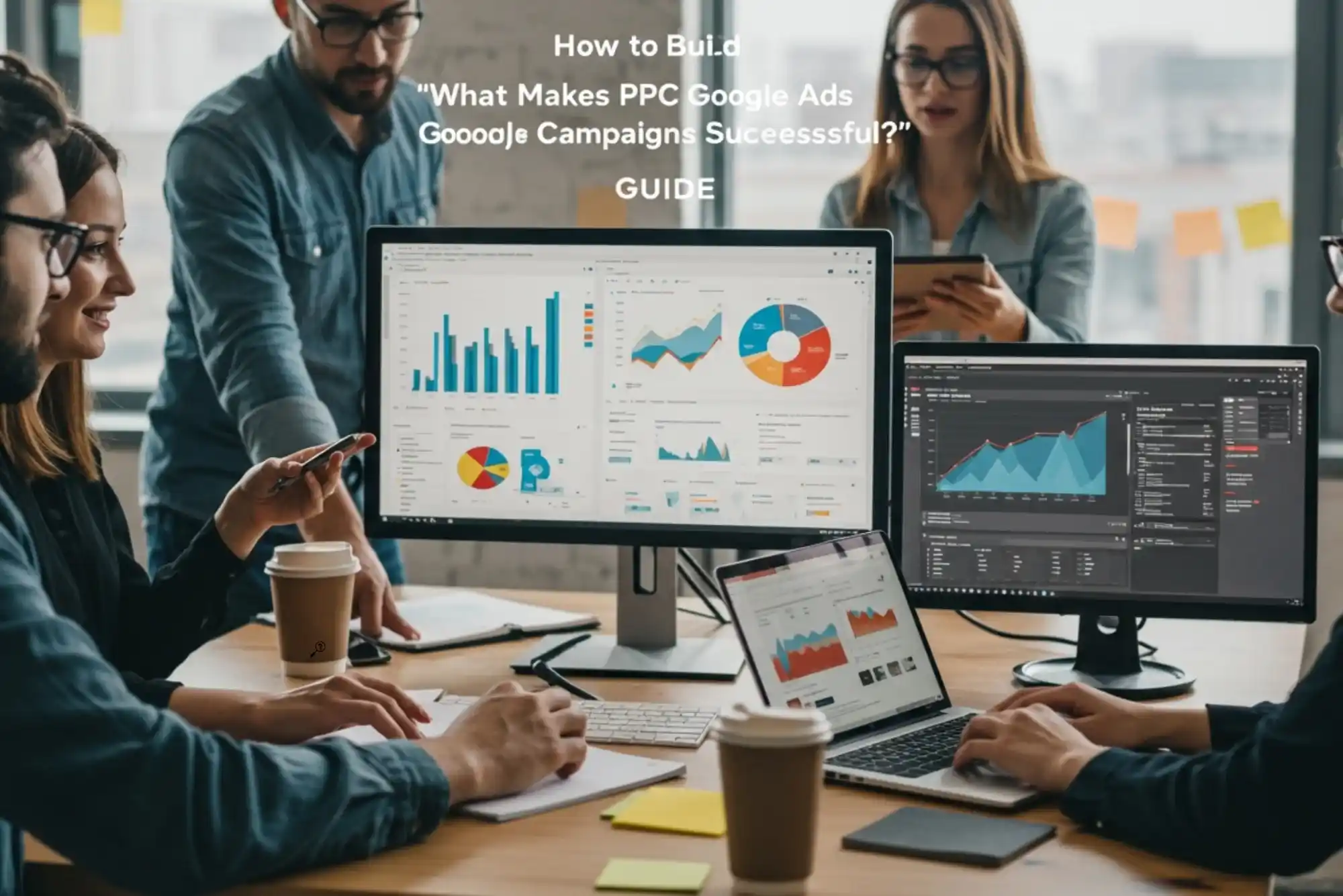Pay-per-click (PPC) advertising has become one of the most powerful marketing tools for businesses looking to increase visibility, attract new customers, and achieve measurable growth. When managed effectively, PPC Google Ads campaigns can deliver incredible results, offering precise targeting and instant traffic. However, achieving true success goes beyond simply creating an ad and setting a budget. It requires strategy, optimization, and a deep understanding of audience behavior.
In this blog, I’ll break down what makes a PPC Google Ads campaign successful and how integrating Social Media Marketing can elevate your digital strategy.
Understanding the Power of PPC Google Ads
Before diving into what makes a campaign successful, it’s important to understand why PPC Google Ads is such a valuable marketing channel. Unlike traditional advertising, PPC allows businesses to pay only when a user clicks their ad. This model ensures that your budget is spent on generating tangible interest rather than just impressions.
Google Ads, in particular, dominates the PPC landscape. It gives brands the ability to appear at the top of search results when users type in specific keywords. This level of visibility is unmatched, and when combined with the right targeting strategy, it can lead to high conversion rates and impressive ROI.
Businesses of all sizes—whether local stores or international brands—use PPC to reach customers at the perfect moment: when they are actively searching for products or services.
Setting Clear Goals and Objectives
The first step in running a successful PPC campaign is defining what success looks like. Too often, advertisers launch campaigns without a clear sense of purpose. Do you want to increase website traffic, generate leads, or boost online sales? Each objective requires a unique strategy.
For example, an e-commerce store might focus on conversions and return on ad spend (ROAS), while a service-based business may prioritize lead generation or phone calls. Setting clear goals ensures that every decision—from keyword selection to ad copy—is aligned with a measurable outcome.
When your objectives are clear, it’s easier to track progress and make data-driven adjustments. A successful PPC Google Ads campaign is never static; it evolves based on performance metrics and customer behavior.
Crafting the Perfect Keyword Strategy
Keywords are the foundation of every PPC campaign. They connect your ads with the right audience and determine how often your ads appear in search results. A successful campaign depends on finding the right balance between high search volume and low competition.
Start by identifying relevant keywords that reflect your audience’s intent. For instance, a user searching for “affordable web design services” is more likely to convert than someone searching for “web design inspiration.” Using keyword match types—broad, phrase, or exact—helps refine targeting and control which searches trigger your ads.
Negative keywords are equally important. By excluding irrelevant terms, you prevent your ads from showing to users who are unlikely to convert, saving your budget for high-value clicks.
The key is constant optimization. Regularly reviewing keyword performance helps you identify which ones drive results and which ones waste ad spend.
Compelling Ad Copy That Converts
Your ad copy is where creativity meets strategy. It’s your first impression and the deciding factor in whether a user clicks or scrolls past. A well-crafted ad copy should speak directly to the user’s intent, offering a clear benefit or solution.
Successful PPC Google Ads campaigns use strong headlines, persuasive language, and compelling calls to action. The copy must align with the keywords and landing page content, ensuring a seamless user experience.
For instance, if your keyword is “emergency plumbing services,” your ad should highlight fast response times, reliability, and perhaps even a 24/7 service promise. Relevance and authenticity are key—Google rewards ads that accurately match user intent with higher Quality Scores, reducing cost-per-click and improving ad positioning.
Optimized Landing Pages for Maximum Conversions
Even the best ad won’t deliver results if the landing page fails to convert visitors. Once users click, the landing page must continue the conversation the ad started. Consistency between the ad and landing page builds trust and encourages users to take action.
An effective landing page is clean, focused, and fast-loading. It should have a strong headline, concise messaging, and a visible call to action. Avoid clutter and distractions—every element should guide the visitor toward conversion.
Trust signals like testimonials, security badges, or guarantees can also enhance credibility. Remember, the goal is not just to attract clicks but to convert those clicks into meaningful results.
Data-Driven Optimization and A/B Testing
A major advantage of PPC advertising is the ability to measure everything. Google Ads provides detailed analytics on impressions, clicks, conversions, and more. Successful advertisers use this data to make informed adjustments, continually improving campaign performance.
A/B testing plays a crucial role in this process. By testing different versions of your ads—such as headlines, calls to action, or visuals—you can determine which elements resonate most with your audience. Over time, small improvements can lead to significant gains in performance and ROI.
Analyzing performance metrics also helps you identify trends and uncover new opportunities. For instance, you might find that mobile users convert better than desktop users, prompting you to adjust your bid strategy accordingly.
Budget Management and Bidding Strategies
Budgeting and bidding are where strategy meets financial control. A common mistake among advertisers is setting budgets too high or too low without aligning them to campaign goals.
Successful PPC Google Ads campaigns focus on smart bidding—adjusting bids based on performance data, audience segments, and device usage. Google’s automated bidding strategies, such as Target CPA (Cost Per Acquisition) or Maximize Conversions, can be effective when used correctly.
However, automation should never replace human oversight. Constant monitoring ensures that your budget is being used efficiently and that you’re not overspending on underperforming keywords or audiences.
Integrating Social Media Marketing for Broader Reach
While PPC Google Ads focuses on search-based intent, combining it with Social Media Marketing can amplify your reach and brand awareness. Platforms like Facebook, Instagram, and LinkedIn allow advertisers to engage users based on interests, behaviors, and demographics rather than search intent.
For instance, a brand might use PPC to capture high-intent users ready to buy while running social media ads to build awareness and nurture potential customers. This integrated approach creates multiple touchpoints across the buyer’s journey.
Social Media Marketing also provides valuable retargeting opportunities. By reconnecting with users who have interacted with your website or Google Ads, you increase the chances of conversion through personalized messaging.
In essence, the combination of PPC Google Ads and Social Media Marketing offers a holistic digital strategy that balances direct response with long-term brand growth.
Monitoring, Reporting, and Continuous Improvement
Success in PPC is not achieved overnight. It’s the result of consistent monitoring, reporting, and ongoing optimization. The best campaigns are those that evolve over time through experimentation and learning.
Regular reporting helps identify which keywords, ads, and audiences deliver the best ROI. It also provides insights into user behavior, such as which times of day or devices drive the most conversions. These insights inform future decisions, allowing you to refine targeting and messaging for even better performance.
Remember, every click is a learning opportunity. The more you test, analyze, and adapt, the stronger your campaigns become.
The Human Touch Behind Successful Campaigns
While technology, data, and automation play crucial roles in PPC, the human touch remains irreplaceable. Understanding customer psychology, crafting authentic messaging, and building trust are things algorithms can’t replicate.
A successful PPC Google Ads campaign combines analytical precision with emotional intelligence. It requires both strategic thinking and creative storytelling—because behind every click is a real person making a decision.
Conclusion
Success in PPC advertising is not about spending more money—it’s about spending smartly. When executed with strategy, creativity, and consistency, PPC Google Ads campaigns can deliver measurable growth and long-term value.
From setting clear goals and optimizing keywords to crafting engaging ad copy and integrating Social Media Marketing, every step contributes to success. Ultimately, the best campaigns are those that evolve, adapt, and connect meaningfully with their audience.









